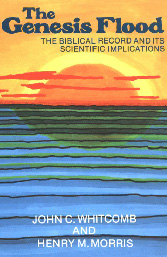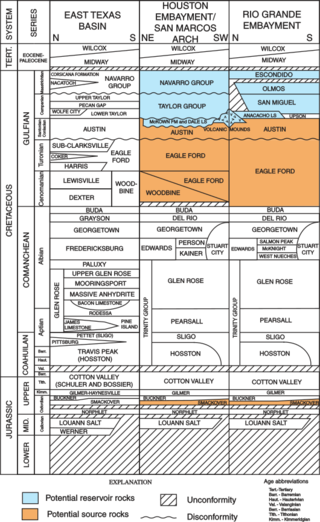Related Research Articles

Somervell County is a county on the Edwards Plateau in the U.S. state of Texas. As of the 2020 census, its population was 9,205. Its county seat is Glen Rose. The county is named for Alexander Somervell, secretary of war for the Republic of Texas.

Young Earth creationism (YEC) is a form of creationism which holds as a central tenet that the Earth and its lifeforms were created by supernatural acts of the Abrahamic God between about 6,000 and 10,000 years ago. In its most widespread version, YEC is based on the religious belief in the inerrancy of certain literal interpretations of the Book of Genesis. Its primary adherents are Christians and Jews who believe that God created the Earth in six literal days. This is in contrast with old Earth creationism (OEC), which holds literal interpretations of Genesis that are compatible with the scientifically determined ages of the Earth and universe. It is also in contrast to theistic evolution, which posits that the scientific principles of evolution, the Big Bang, abiogenesis, solar nebular theory, age of the universe, and age of Earth are compatible with a metaphorical interpretation of the Genesis creation account.

Flood geology is a pseudoscientific attempt to interpret and reconcile geological features of the Earth in accordance with a literal belief in the Genesis flood narrative, the flood myth in the Hebrew Bible. In the early 19th century, diluvial geologists hypothesized that specific surface features provided evidence of a worldwide flood which had followed earlier geological eras; after further investigation they agreed that these features resulted from local floods or from glaciers. In the 20th century, young-Earth creationists revived flood geology as an overarching concept in their opposition to evolution, assuming a recent six-day Creation and cataclysmic geological changes during the biblical flood, and incorporating creationist explanations of the sequences of rock strata.

Arthur Ernest Wilder-Smith, FRSC was a British organic chemist and young Earth creationist.

The Genesis Flood: The Biblical Record and its Scientific Implications is a 1961 book by young Earth creationists John C. Whitcomb and Henry M. Morris that, according to Ronald Numbers, elevated young Earth creationism "to a position of fundamentalist orthodoxy."
Carl Edward Baugh is an American young Earth creationist. Baugh has claimed to have discovered human footprints alongside non-avian dinosaur footprints near the Paluxy River in Texas. Baugh promoted creationism as the former host of the Creation in the 21st Century TV program on the Trinity Broadcasting Network.

Dinosaur Valley State Park is a state park near Glen Rose, Texas, United States.

The Paluxy River, also known as Paluxy Creek, is a river in the U.S. state of Texas. It is a tributary of the Brazos River. It is formed by the convergence of the North Paluxy River and the South Paluxy River near Bluff Dale, Texas in Erath County and flows a distance of 29 miles (47 km) before joining the Brazos just to the east of Glen Rose, Texas in south central Somervell County.

A fossil track or ichnite is a fossilized footprint. This is a type of trace fossil. A fossil trackway is a sequence of fossil tracks left by a single organism. Over the years, many ichnites have been found, around the world, giving important clues about the behaviour of the animals that made them. For instance, multiple ichnites of a single species, close together, suggest 'herd' or 'pack' behaviour of that species.

Footprints are the impressions or images left behind by a person walking or running. Hoofprints and pawprints are those left by animals with hooves or paws rather than feet, while "shoeprints" is the specific term for prints made by shoes. They may either be indentations in the ground or something placed onto the surface that was stuck to the bottom of the foot. A "trackway" is a set of footprints in soft earth left by a life-form; animal tracks are the footprints, hoofprints, or pawprints of an animal.

The Glen Rose Formation is a shallow marine to shoreline geological formation from the lower Cretaceous period exposed over a large area from South Central to North Central Texas. The formation is most widely known for the dinosaur footprints and trackways found in the Dinosaur Valley State Park near the town of Glen Rose, Texas, southwest of Fort Worth and at other localities in Central Texas.
Leonard Brand is a Seventh-day Adventist creationist, biologist, paleontologist, and author. He is a professor and past chair of Loma Linda University Department of Earth and Biological Sciences.

The Creation Evidence Museum of Texas, originally Creation Evidences Museum, is a creationist museum in Glen Rose in Somervell County in central Texas, United States. Founded in 1984 by Carl Baugh for the purpose of researching and displaying exhibits that support creationism, it portrays the Earth as six thousand years old and humans coexisting with dinosaurs, disputing that the Earth is approximately 4.5 billion years old and dinosaurs became extinct 65.5 million years before human beings arose.

The Mt. Blanco Fossil Museum was a creationist museum in Crosbyton, Texas, United States, opened in 1998. Its motto was "Digging up the facts of God's Creation: One fossil at a time."

A creationist museum is a facility that hosts exhibits which use the established natural history museum format to present a young Earth creationist view that the Earth and life on Earth were created some 6,000 to 10,000 years ago in six days. These facilities generally promote pseudoscientific biblical literalist creationism and contest evolutionary science. Their claims are dismissed by the scientific community.
The Moab Man is a find of several human skeletons found after bulldozing in a mine whose rock dated to the Early Cretaceous period, about 140 million years ago. The original discovery of two individuals was made in 1971 by Lin Ottinger in the Keystone Azurite Mine near Moab, Utah, and has been used by creationists as an argument for humans coexisting with dinosaurs. John Marwitt, an archaeologist and the field director for the Utah Archaeological Survey, examined the fossils and concluded that the fossils were probably only hundreds of years old, the result of burials of Native Americans.

The Mysterious Origins of Man is a pseudoarchaeological television special that originally aired on NBC on February 25, 1996. Hosted by Charlton Heston, the program presents the fringe theory that mankind has lived on the Earth for tens of millions of years, and that mainstream scientists have suppressed the fossil evidence for this. Some material included was based on Forbidden Archeology, a book written by Hindu creationists Michael Cremo and Richard L. Thompson about anomalous archeological finds reported mainly in early scientific journals. The film covers topics such as The Paluxy tracks, the Zuiyo-maru carcass, the Missing Link, the Java Man, Lucy, Tiwanaku, Stonehenge, the Giza pyramids, the Piri Reis map, Atlantis, and the Pole shift hypothesis.

The London Hammer is a name given to a hammer made of iron and wood that was found in London, Texas in 1936. Part of the hammer is embedded in a limey rock concretion, leading to it being regarded by some as an anomalous artifact. The man-made tool is much younger than the Lower Cretaceous rock surrounding it.

The coexistence of avian dinosaurs (birds) and humans is well established historically and in modern times. The coexistence of non-avian dinosaurs and humans exists only as a recurring motif in speculative fiction, because in the real world non-avian dinosaurs have at no point coexisted with humans.
Roland Thaxter Bird was an American palaeontologist. He is best known for his discovery of fossil trackways of the Paluxy River in Texas, and work with the American Museum of Natural History.
References
- ↑ "My Background". Glen Kuban website.
- ↑ Neufeld, Berney, 1975, Dinosaur Tracks and Giant Men. Origins, Vol. 2, No. 2, pp. 64-76
- ↑ Hastings, Ronnie J. (September 1988). "The Rise and Fall of the Paluxy Mantracks". Perspectives on Science and Christian Faith . American Scientific Affiliation . Retrieved 14 June 2017.
- 1 2 Wilford, John Noble (17 June 1986). "Fossils of 'Man Tracks' Shown to Be Dinosaurian". The New York Times . Retrieved 14 June 2017.
- ↑ Hastings, Ronnie J. (Winter 1985). "Tracking Those Incredible Creationists". Creation/Evolution . National Center for Science Education . Retrieved 14 June 2017.